A Moorish Sheet of Playing Cards
This article was originally published in “The Playing-Card”, the Journal of the International Playing-Card Society (London), Volume XV, No.4, May 1987.
Whilst visiting the Instituto Municipal de Historia in Barcelona last Christmas 1, we stumbled across a rather special sheet of unidentified playing cards. At first glance, they look hardly like playing cards at all, and to an unacquainted observer would be disregarded.
Editor's note: this article has been superceded by newer discoveries.
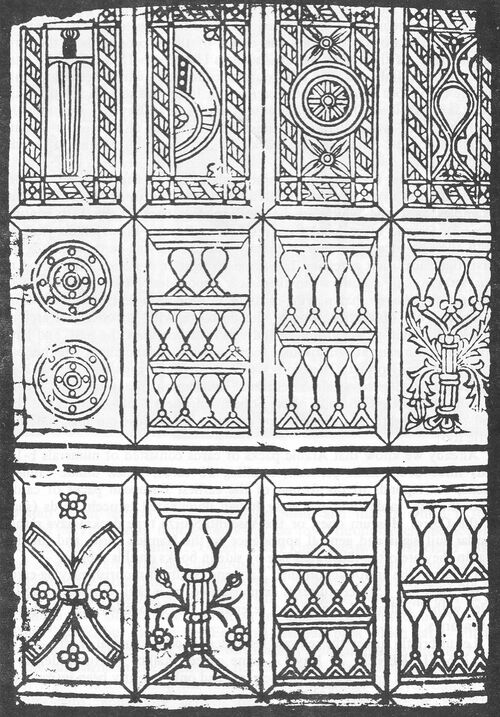 Consisting of three rows of four cards, printed in heavy black outlines on whitepaper, the sheet shows 12 cards. Examination of the edges of the sheet reveals that the original block contained at least 4 more cards, but which have been cut off our example. On the first row are an ace of swords, vertical and pointing downwards, followed by what we must consider to be the ace in a suit equivalent of batons, i.e. curved clubs, polo-sticks or similar. The third card in the top row is an ace of coins or discs and the fourth an ace of cups. Admittedly, the cup does not look quite the same as a cup on ordinary European playing cards, but comparison with other Arabic cards permits this association. These four cards are distinguished from the others on the sheet by their broader borders which incorporate a sort of spiral ribbon round a central shaft, with floral motifs at each corner.
Consisting of three rows of four cards, printed in heavy black outlines on whitepaper, the sheet shows 12 cards. Examination of the edges of the sheet reveals that the original block contained at least 4 more cards, but which have been cut off our example. On the first row are an ace of swords, vertical and pointing downwards, followed by what we must consider to be the ace in a suit equivalent of batons, i.e. curved clubs, polo-sticks or similar. The third card in the top row is an ace of coins or discs and the fourth an ace of cups. Admittedly, the cup does not look quite the same as a cup on ordinary European playing cards, but comparison with other Arabic cards permits this association. These four cards are distinguished from the others on the sheet by their broader borders which incorporate a sort of spiral ribbon round a central shaft, with floral motifs at each corner.
The remaining eight cards are the 2, 3 and 7 - 10 of cups, the 2 of coins and a 2 of the curved batons suit already described. Three of these cards are additionally decorated with flowers, buds and leafy patterns. The design of the "two of batons" resembles the design of the swords cards in the early variant form of the Italian pattern, which became extinct by the early 16th century. The presence of a 10 on this sheet is an important clue, as we shall see, not only because it allows us to be fairly sure that the complete pack would have contained 52 cards, but also helps us to date it in relation to other Spanish packs which, generally, contain 48 cards, without 10's.
What is rather exciting about these cards is that on the one hand they are clearly derived from, or closely related to, the Mamluk cards of which various examples exist and which are believed to date back to the 13th century. On the other hand they reside in a Spanish history library, along with the rest of a collection of mainly Spanish playing cards, which is the first time any such specimen has come to light in Europe. They come to our attention at a time when there is a strong desire to find evidence to support the theory that playing cards in Europe were derived from Muslim cards.
Already we know that Arabic packs of cards consisted of numerals 1 - 10, plus 3court cards per suit, totalling 52 cards, which unlike Chinese packs, corresponds to the format of the earliest European packs of cards. Also the pip cards from the early Italian illuminated Tarocchi cards (such as the Correr Museum ones, or the Visconti-Sforza type decks) have rather similar suit signs and general appearance to the Mamluk cards, and for this reason they are often illustrated side by side in books on this subject.
Certainly the introduction into Italy and Spain of Moorish playing cards in the 14th and 15th centuries is demonstrated, as is their existence side by side with "ordinary" ones, by references in chronicles and property inventories.
Let us briefly survey the relevant references in chronological order:
-
1376, FLORENCE, Italy. 23 May.
A game called 'naibbe' is forbidden in a decree, with the implication that the game had only recently been introduced there.
-
1377, BASLE
"Tractatus de moribus et disciplina humanae conversationis" written by a Dominican friar by the name of John. The pack described by him in his sermon, "in its common form, and that in which it first reached us", comprises four seated kings, on royal thrones, each one holding a certain sign in his hand... Under which kings are two 'Marschalli', the first of whom holds the sign upwards in his hand, in the same manner as the king; but the other holds it downwards in his hand. After this there are ten other cards, outwardly of the same size and shape, containing pips one to ten, making a total of 52. This description corresponds not only to our modern "Poker" pack, but also to the Egyptian Mamluk pack which has a "First" and "Second" viceroy (Na'ib). Unfortunately, a description by brother John of the suit signs in the pack does not exist, and so we are still floundering with regard to explaining the simultaneous appearance all over Europe of playing cards, apparently derived from "Saracen" influence in the first place (see below), and which 50 - 60 years later had multiplied into a profusion of suit symbols of every imaginable variety.
-
1379, VITERBO, ITALY
The year in which it is claimed that a new game called 'nayb' was introduced by a 'Saracen' ( = Oriental, Arab or Muslim). This is the much-quoted reference in the "Chronicles of Viterbo" (Viterbo, in Italy, is a little Northwest from Rome), which basically points to an entry in a chronicle of 1379 (now lost) which must have read "In the year 1379 there was brought to Viterbo the game of cards, which in the Saracen language is called nayb". This Arabic word 'Nayb' does not mean playing cards, however, but "deputy" or "viceroy" (i.e. "Jack", the name of the second and third court cards in the Mamluk pack), suggesting that the Italians couldn't pronounce the Arabic word for playing cards, which is "kanjifah", but found the word 'nayb' easier, and so it caught on. This word also turns into "naipes" in Spanish, which is still used today.
Whilst not actually stating that the game of cards came to Viterbo from the Muslim world, nevertheless, the reference does have strong implications.
-
1380, BARCELONA, Spain
The inventory, dated 26th October 1380, kept by the Barcelona merchant Nicolas Sarmona... lists "a game of cards (nayps) of 44 pieces"; a strange number which could equally well refer to two sets of tarot trumps or to a (normal) deck with 4 cards missing (or to an incomplete pack).The same word for cards seems to have been used as in the Viterbo reference above.
After this come several fourteenth and fifteenth century inventory references, prohibitions, etc. from Barcelona and Valencia, up till 1460, in which "Moorish" playing cards are often listed in distinction to "ordinary small" playing cards. It is of possible relevance as background knowledge that the date of the last outbreak of Bubonic plague (Black Death) which afflicted the west in the middle of the fourteenth century coincides with the earliest dates relating to the appearance of playing cards in Europe. It is to be supposed that any clothes, bedding, papers or other personal effects belonging to plague victims would have been burnt, and so it is hardly surprising that no evidence to do with cards has survived from prior to these dates, even if there was any.
Returning to our former theme, the question that now poses itself is did early Moorish cards or "nayps" transform themselves into a particular Italian or Spanish pattern, or did they simply die out? In other words, have European cards descended directly from Arabic ones, or were they inspired by them but given different faces, or were they conceived quite independently, or from other sources? Although we have evidence confirming a possible interrelationship in Italy and Spain, we also have to account for the presence in Germany of quite a different tradition of playing card designs which on the face of it cannot so easily be compared with Mamluk cards. Perhaps we have the quite spontaneous "invention" of a prototype that was "in the air" at the time, which was given its physical form in styles conforming to local environments and artistic conventions.
This latter explanation of course has the advantage that no continuous threads of physical evidence are necessary to support it, and can be put forward quite reasonably just as the electric light bulb was "invented" independently in two different places, or that monkeys on different but adjacent islands learn more or less simultaneously to wash their food in the sea to remove sand. Communication takes place at a "higher than conscious" level, such as in telepathy.
Let us now look for any likenesses between our "Moorish" sheet of cards and other early examples of playing cards (besides the obvious similarities to Mamluk cards):
(1) Compare with the 1495 Catalan sheet of cards, also in the Instituto Municipal de Historia in Barcelona.
This sheet was found inside the bindings of a copy of "El libre de les Dones" which was printed in 1495 by Johann Rosembach who worked in Catalonia from c.1490 to 1530. The title page of this book contains a woodcut in the same massive style with strong vertical black lines which characterises the sheet of cards. It is perfectly conceivable that the sheet of cards was a printer's proof produced in the same workshop, and subsequently used as stiffening for the book-covers, and so on the basis of this association I shall label this the "Rosembach" sheet. Observe, on the "Moorish" sheet, the bold black outlines, the leaf and floral decorations, the design of the coins, etc., similar to Rosembach's style. A possible explanation is that Rosembach, or whoever made them, made both sheets for different clients, since we know that "Moorish" and "ordinary" playing cards were recognised.
(2) Turning now to Italy, compare with Fournier's early Italian pack (No.3) and observe the swords curving outwards in the same manner that the two of batons does on the Moorish sheet, the curved ace of swords resembling the curved ace of batons on the Moorish sheet, and similar leaf motifs. There are also the short lines at each corner looking like "turn-over" lines for back papers. Can we entertain the possibility that these Italian cards were based upon some earlier Moorish cards "introduced by a Saracen?"
However, if we cannot see much of a link here, we must look to some slightly earlier Italian cards, and as I have already mentioned there is more than a passing similarity between Bembo's pip cards and Mamluk cards. But regarding the Moorish sheet, I cannot suggest any striking resemblances. There is also the knight of batons from the Rome archives (c.1450) which has a knobbly cudgel like the Rosembach cards, but again no striking link with this Moorish sheet.
An odd card, the three of cups, from a fifteenth century Italian deck, probably the same as those in the Cary collection at Yale University, exists in the Benaki museum, Athens. Whilst this card does not resemble either of the Instituto Municipal de Historia sheets, its existence points towards trade between Italy and Muslim Egypt, since the card was probably obtained in Egypt. (It is interesting to note in passing that the arrangement of the cups is like the Master of the Banderoles' and the South German Engraver's versions, one cup above two more side-by-side). Two torn-in-half 16th century Italian cards have also been found in rubble heaps in Fostat, the first Arab settlement after the Muslim conquest.
In the latter of the above-mentioned articles is also illustrated a fragment of what looks somewhat like an ace of coins, but which has been deemed not to be a playing card at all. Although the second of the aces on our Moorish sheet shows a curved form - looking like part of a larger oval - that could open some fresh discussion regarding this other doubtful fragment, I am still inclined to agree with the consensus of opinion on this point.
(3) Compare with the "Liechenstein" sheets, and apart from the supposed suit of polo-sticks, the only similarity we find is that the kings are sitting on Gothic thrones as we find in German cards, the Bembo cards, the Minchiate cards, the early dragon cards, also calling to mind the manner in which the kings are represented symbolically in the Mamluk cards, on a square base.
(4) In some versions of the Tarocchini di Bologna pack the first four trumps, unnumbered, depicted figures similar to moors or satraps (= Persian governors). This continued even into the 19th century, but its original occurrence may partly be due to a lingering association with Muslim influences. Similarly, the alla Colonna cards made in Rome in 1613 show a Sultan instead of the Pope on trump no.5, and these cards also have spiral decorative designs around the borders.
When we look at the shape of the "cups" on these Moorish cards it has to be granted that they resemble the earlier Italian cup designs more than any Spanish ones, with the possible exception of the "Rosembach" sheet of c.1490, and of Francisco Flores' cards. However, in nearly all the above comparisons the case amounts to very little in favour of establishing a direct link between the Moorish sheet of cards and any European cards, apart from incidentals.
In 1492, the year that Columbus set sail from Palos for the Americas, Granada in Spain was at last returned to Spanish allegiance. Ferdinand and Isabella, whose victory over the Muslim Boabdil brought to completion the Christian reconquest that had been a lasting preoccupation of medieval Spain, also assisted Columbus' expedition and so gave considerable impetus to the birth of an entirely new era. Two years later, in 1494, we hear for the first time of a 'New World' as applied to Columbus' discoveries.
When the moors were exiled from Granada, a long-standing respect for each other's artistic traditions continued, as demonstrated by Spanish architecture and pottery. The Mudejars were the moors who remained behind, living as Muslims in a Christian kingdom with communities and privileges of their own. In fact Spanish trade was enhanced due to the Moorish influences in its wares, which found markets all over the Christian West. Spanish pottery was very sought after, and even today Moresque decorations can be recognised on tourist and traditional pottery pieces.
For the above reasons, I am inclined to favour my comparison No. 1) above, namely that the "Moorish" sheet of cards in the Instituto Municipal de Historia was manufactured in Spain, possibly by a Catalan card-maker, to cater for Moorish tastes in playing-cards, but who inadvertently contaminated the cards with stylistic features of his own, such as leaves and spiral scroll borders, which are often seen in European mediaeval manuscript decorations. We appear, at last, to have an example of a design that was in use alongside the "ordinary" Spanish pattern of the time, in all probability a popular, cheaper version of what the Mamluk cards is a luxury, hand-painted version of. It is possible that Spain herself had the distinction of being the receivers of such playing cards from the moors who were actually occupying the country until 1492 - for over700 years. How could they fail to introduce playing cards - that is assuming that they had any? They have left plenty of other evidence of their presence there.
As for the date of the cards, the earliest inventory date to Moorish cards in Barcelona is 1414. There is no reason why they could not be as early as this, although prudence in the face of what is quite an open guess brings us to the 10 of cups. Spanish packs after 1500 tended to contain only 48 cards, without 10's. 10's appear to have been dropped from Spanish packs more or less at the same time as aces were dropped from German ones, and so we must tentatively date the sheet as fifteenth century, between 1414 and 1495. On the face of it, book printing does not seem to have been introduced into Spain much before 1475 (earlier in Italy), although there is no reason why woodblock printing could not have been used since much earlier for textile-printing. We know that the Arabs have always been gifted regarding inventiveness. One Spanish researcher into printing history whom I spoke to recently explained his belief that the moors, in his opinion, would have most likely made playing cards from stencils alone, without a previously printed picture, applying the various colours successively to 'paint' their cards. However, he had not found any supportive evidence, apart from his own experiments, but he felt rather certain.
Unless my theory of different people "hitting upon the same idea", telepathically or otherwise, because its imminent invention had become inevitable all over Europe, is correct, then an "evolution" theory could be proposed in that either a) playing cards were introduced from the Muslim world somewhere (as yet uncertain) into Italy around 1370, and were adapted into Italian taste and given more easily identifiable suit symbols, particularly considering the dramatic shift from Muslim to Christian culture. Henceforth they spread to Spain, which was already under Moorish occupation, and were used alongside a "Moorish" pack introduced there independently by Moroccans. An alternative possibility, b) is that it happened the other way round, namely Moorish-type cards introduced into Spain spread to Italy, passing via Basle and all the other places where they have been recorded in literature, getting "Europeanized" on the way. The painted Mamluk-type cards were certainly imitated by the Italians, but there is also a reference, in 1401, to a pack of large, painted, gilded cards in the property inventory of a Barcelona merchant. We have no idea what they looked like; just as we don't really know what the cards painted in 1392 by Grigonneur looked like either.
It is also conceivable that the early variant of the Italian pattern (with outwardly curving swords - see comparison No.2) was a sympathetic imitation of the Mamluk-style curved scimitars on Saracen cards introduced there, which have surreptitiously transmuted themselves into the equivalent of batons in the Moorish sheet we are discussing. Even in Italy some variations on this theme were permitted, since the Cary-Yale Visconti-Sforza Tarocchi cards have straight swords and straight arrows instead of batons, whilst other packs have curved swords. In the replacement cards to the incomplete set of Mamluk cards in the Topkapi Sarayi Museum, Istanbul, which are probably later, there is a much more Italian-looking 10 of swords, again demonstrating that styles were not rigid.
In order better to trace what is a very ubiquitous aspect of our cultural heritage, it helps to have more than a superficial familiarity with the kaleidoscope of contemporary history, the changing institutions and the interactions of events through which playing cards have come to us. Trade, politics, technology, disease, war and all the rest of the process of time impinge and interact with each other, twisting and turning our history through many unexpected channels, many of which we would not have deemed likely until after they had happened. I have attempted to put together the above observations with these complex influences in mind.
References
- 1986
- In fact there were two sheets; the second sheet can be viewed here
- Such as ITA sheets 1S & 2S in the Cary collection, or Italy No.3 in the Fournier collection. See XV Century Italian Playing Cards
- See The History of Playing Cards
- See The Visconti-Sforza Tarot, c.1460
- See Denning p.17, note iv, quoting Gorostiza.
- See Michael Dummett's illuminating account of these references in chapter 3, pp.42 and 43, of his book "The Game of Tarot".
- Biographical information about J. Rosembach has been kindly supplied to me by Sra. Alicia Gomez of the I.M.H. Alleged to be a native of Heidelberg, Rosenbach came to Spain as a printer and printer's supplier, and set up business in Valencia in 1490. In 1492 he moved to Barcelona and subsequently set up printing businesses at Perpignan, Tarragona and Montserrat monastery. He was often commissioned to print breviaries and missals for the church, and was also a talented woodcutter. Rosembach enjoys a prominent place in the history of printing in Catalonia, and the list of his productions goes on until 1530. The frontispiece illustration from "El Libre de les Dones" is illustrated in Douglas Percy Bliss' "A History of Wood Engraving", London 1928.
- See XV Century Italian Playing Cards
- For illustrations see "Gatherings in honour of Dorothy E. Miner", edited by Ursula McCracken and published by the Walters Art Gallery,1974 and "A note on some Fragments in the Benaki Museum" by Michael Dummett, published in "Art and Archaeology Research Papers", no.4, Dec 1973.
- Excellent illustrations both of which can be seen in Trevor Denning's book "Spanish Playing Cards".
- See Mamluk Playing Cards

By Simon Wintle
Member since February 01, 1996
Founder and editor of the World of Playing Cards since 1996. He is a former committee member of the IPCS and was graphics editor of The Playing-Card journal for many years. He has lived at various times in Chile, England and Wales and is currently living in Extremadura, Spain. Simon's first limited edition pack of playing cards was a replica of a seventeenth century traditional English pack, which he produced from woodblocks and stencils.
Trending Articles
Popular articles from the past 28 days
Related Articles
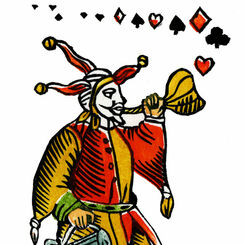
Woodblock and Stencil Joker
A limited edition art print of the 1984 woodblock joker.
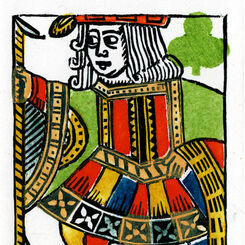
Woodblock and Stencil Jack of Clubs
A limited edition art print of the Jack of Clubs 1984 woodblock joker.
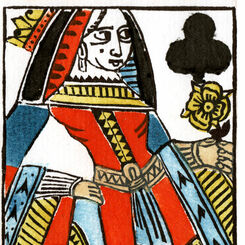
Woodblock and Stencil Queen of Clubs
A limited edition art print of the Queen of Clubs 1984 woodblock joker.
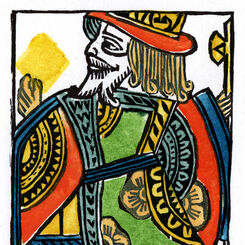
Woodblock and Stencil King of Diamonds
A limited edition art print of the King of Diamonds 1984 woodblock joker.
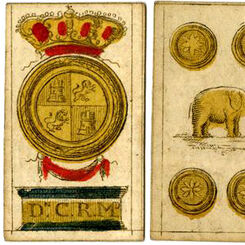
Miniature spanish-suited playing cards
Pack of 48 miniature spanish playing-cards published by C R.
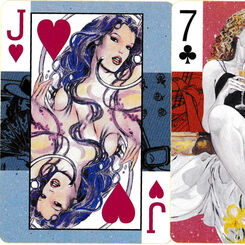
Manara: baraja de poker
Exotic illustrations by Italian comic book artist and writer Milo Manara.
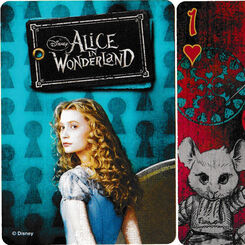
Alice in Wonderland
Alice in Wonderland collector’s edition with illustrations of characters from the film, published by...
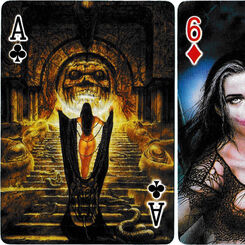
Women by Royo
‘Women by Royo’ erotic playing cards published by Heraclio Fournier, Spain, 2001.
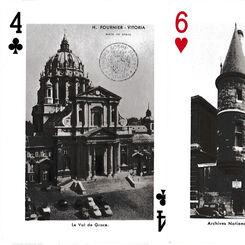
Monuments de Paris
‘Monuments de Paris’ souvenir playing cards produced by Heraclio Fournier, c.1964.
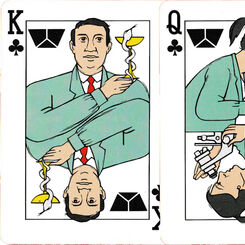
B. Braun-Dexon®
Publicity pack promoting B. Braun-Dexon’s atraumatic needles, with non-standard courts and pips.
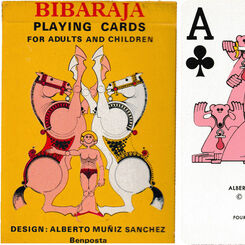
Bibaraja
Amusing designs of boys as circus performers by Alberto Muñiz Sánchez.
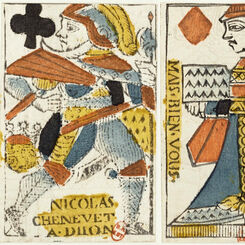
Burgundy pattern
The old Burgundy (or Burgundian) pattern by Nicolas Chenevet, Dijon.
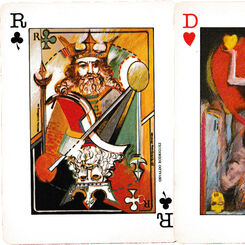
Peintres Latino Americains
Original artwork by 18 different Latin American artists.
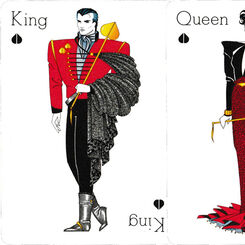
Paco Lobo
Highly original and striking designs by Paco Lobo for the fashion house of the same name.
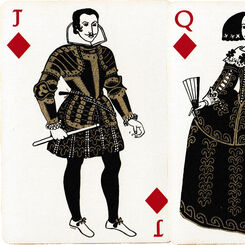
Loewe: Moda Europea Siglo XVII
Luxury pack for the Spanish fashion house Loewe, with 17th century costume designs by Margot Hamilto...
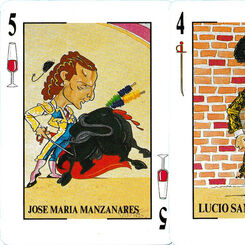
Toros: De El Cordobés a Espartaco
Publicity pack for the Spanish newspaper Ya with caricatures of famous bullfighters by Fernan...
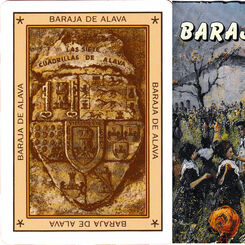
Baraja de Alava
55 different paintings by Emilio Lope depicting the history and culture of Vitoria and the province ...
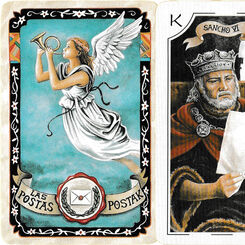
Postak – Las Postas
‘Postak - Las Postas’ playing cards commemorating the history of the Basque postal service, Spain, 1...
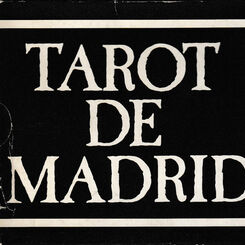
Tarot de Madrid
Black-and-white photographs of models whose faces are made up using elements found on the major arca...
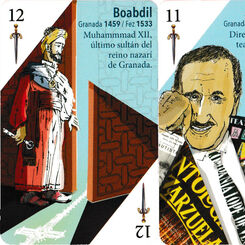
Naipes de Personajes Granadinos
Forty famous men and women with links to Granada, on a pack designed by Rubén Garrido.
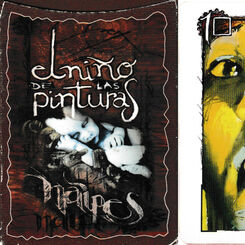
El Niño de las Pinturas
Forty-nine distinctive works by Spanish graffiti artist Raúl Ruiz.
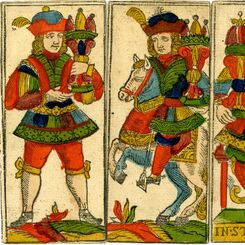
Trappola pack by Joseph Fetscher
Trappola pack published by Joseph Fetscher, Graz, 1739.
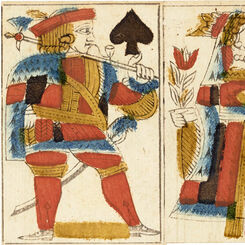
Lyon pattern by Michel Ressy
Lyon pattern by Michel Ressy, c.1760.
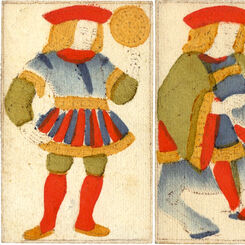
Pere Pau Rotxotxo Puigdoura
Spanish national pattern by Pere Pau Rotxotxo Puigdoura (1766–1797).
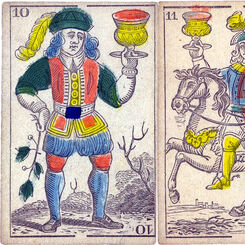
Spanish-suited deck by J.Y. Humphreys
A rare Spanish-suited deck published by J.Y. Humphreys, Philadelphia, c.1816.
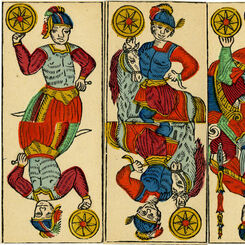
Trappola pack by Anton Herrl
Trappola pack of 36 double-ended cards published by Anton Herrl, Graz, Austria.
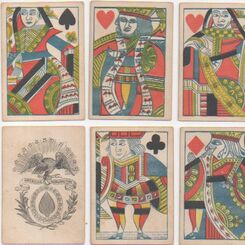
75: Early American cards
An overview of some of the early cards made in the United States.
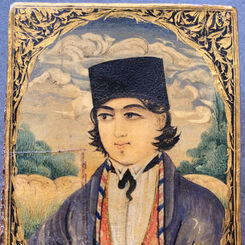
Âs Nas playing cards with box
Hand made cards from Persia
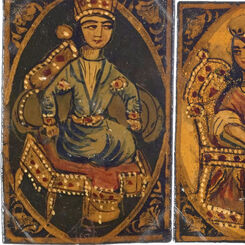
Âs Nas
Âs Nas type playing cards from Persia.
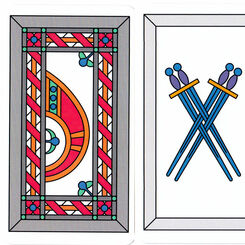
Moorish Deck
Review of “Trzes’ Moorish Deck” facsimile published by Ulrich Kaltenborn, Berlin, 2023.
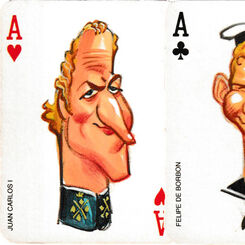
El Jueves playing cards
Caricatures of 52 famous Spaniards for the satirical magazine “El Jueves”.
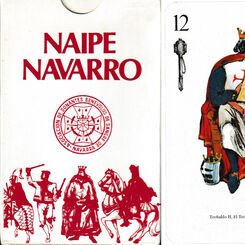
Naipe Navarro
Historical figures and artefacts from Navarre with designs by M. Sinués for the Navarre Association ...
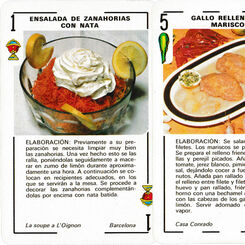
Bankunión playing cards
Ingredients and recipes for 24 dishes from different regions of Spain.
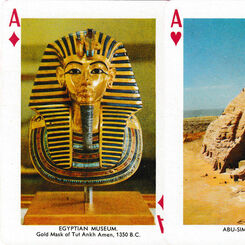
Souvenir Playing Cards of Egypt
55 different photographic views of Egypt in full colour.
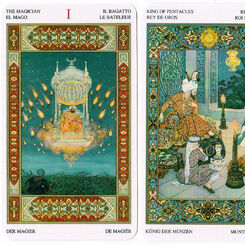
Tarot of the Thousand and One Nights (1001 Nights Tarot)
This tarot deck captures the idealised Eastern world's magic from the eighteenth and nineteenth cent...
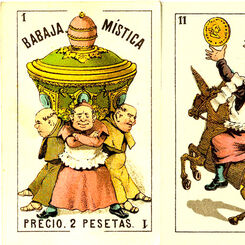
Baraja Mística
‘Baraja Mística’ satirical playing-cards featuring revelling clergy published by Litografía Fernánde...
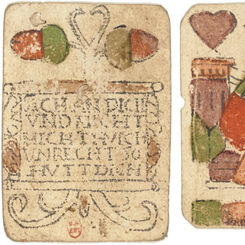
Early German playing cards
Some early examples of popular German playing cards from the XV and XVI centuries.
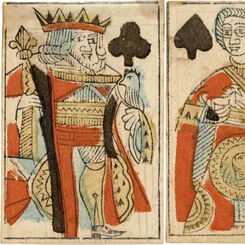
Auvergne Pattern
The Auvergne pattern is one of the oldest in France.
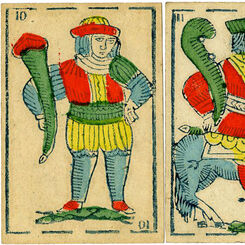
P. Buscaglia: Spanish-suited cards
Spanish-suited cards published by P. Buscaglia, Mele & Genova.
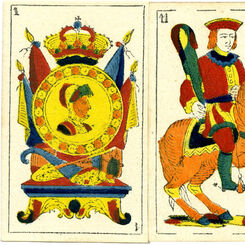
José Maria Durán
Spanish Catalan pattern by José Maria Durán, Barcelona, c.1870.
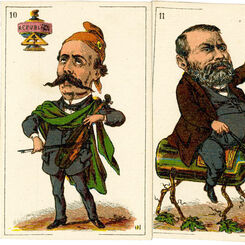
Spanish Political pack
Satirical playing cards manufactured by Francar y Cía depicting political situation, Barcelona, 1872...
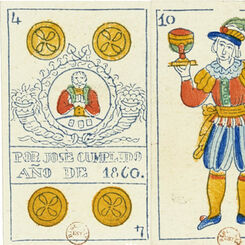
José Cumplido
Raimundo García pattern produced by José Cumplido in Madrid, dated 1860 on the four of coins.
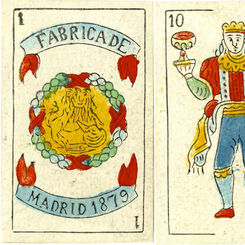
Juan Humanes y Cía
Raimundo García pattern published by Juan Humanes y Cía, Madrid, 1879.
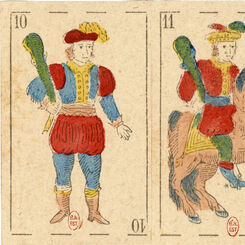
Pou y Cía
Catalan pattern made by Pou y Cía, Madrid c.1860.



